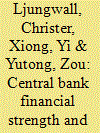| Srl | Item |
| 1 |
ID:
127940


|
|
|
|
|
| Publication |
2014.
|
| Summary/Abstract |
The history of the Bank of Israel is often told as a story that leads from servitude to independence. According to this conception, the bank was a weak and marginal institution during the developmental period of the state, and it turned into an independent actor in the neoliberal period. This article argues that the portrayal of the bank as marginal during the developing period fails to recognize the essential role it played in contributing to the capacity of the state to allocate credit more effectively. It maintains that that Bank of Israel provided the state with market compatible instruments in order to govern the banking system and depoliticized the allocation of credit. The establishment of the bank had two effects on Israel's political economy: it enabled the government to weaken its dependence on the Histadrut as an agent of development and it allowed it to nurture linkages with the private sector.
|
|
|
|
|
|
|
|
|
|
|
|
|
|
|
|
| 2 |
ID:
120626


|
|
|
|
|
| Publication |
2013.
|
| Summary/Abstract |
Using a unique monthly data set over the period 2000:1-2008:12, this paper presents empirical findings on China's central bank, the People's Bank of China, from the viewpoint of its financial strength and the cost of monetary policy instruments. The results show that PBoC is constrained by the costs of its monetary policy instruments. PBoC tend to use less costly but market-distorting instruments such as the deposit interest rate cap and reserve-ratio requirements, rather than more market-oriented but more costly instruments such as central bank note issuance. These costs remain under control today, but may rise in the future as PBoC accumulates more foreign assets. This, in turn, will jeopardize the Chinese monetary authority's capability to maintain price stability.
|
|
|
|
|
|
|
|
|
|
|
|
|
|
|
|
| 3 |
ID:
156438


|
|
|
|
|
| Summary/Abstract |
This paper provides an overview of the operational implementation of negative interest rates in Europe and Japan. Drawing attention to the fact that there is precedent for negative policy rates and negative money market rates, the paper addresses conceptual issues and summarizes measures which define negative interest rate policy. Based on detailed institutional analysis and an examination of the interaction of interest rate policies with balance sheet policies, it is argued that there exists substantial heterogeneity in the purpose, design, and operational specificities of negative interest rate policies across economies, with significant consequences for effective market rates, private sector funding conditions, and expectations. Summarizing transmission channels of negative rates, benefits, and risks of the policy, the paper calls attention to potential adverse effects resulting from the interaction of negative interest rates with tighter liquidity and capital standards adopted since the Global Financial Crisis.
|
|
|
|
|
|
|
|
|
|
|
|
|
|
|
|